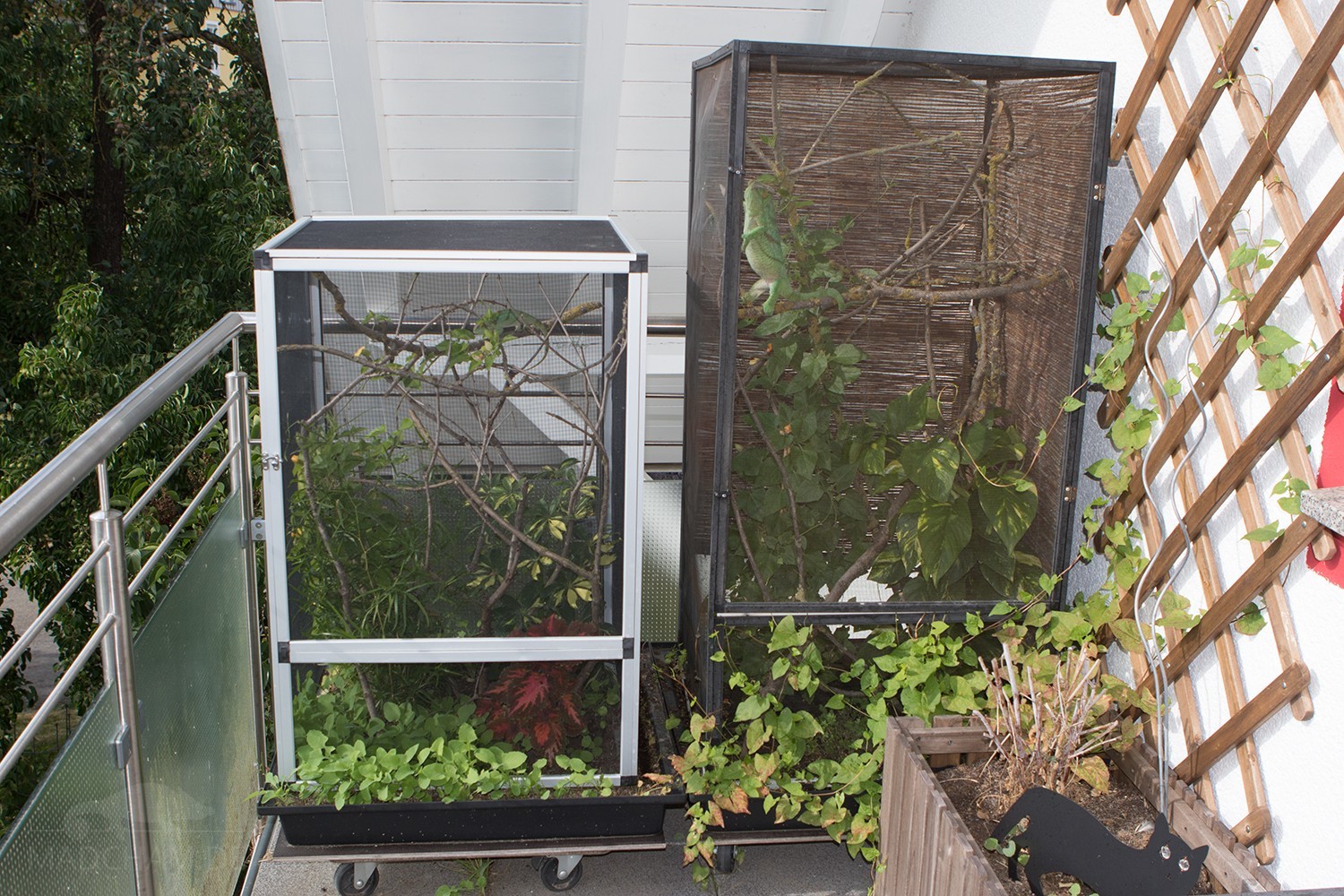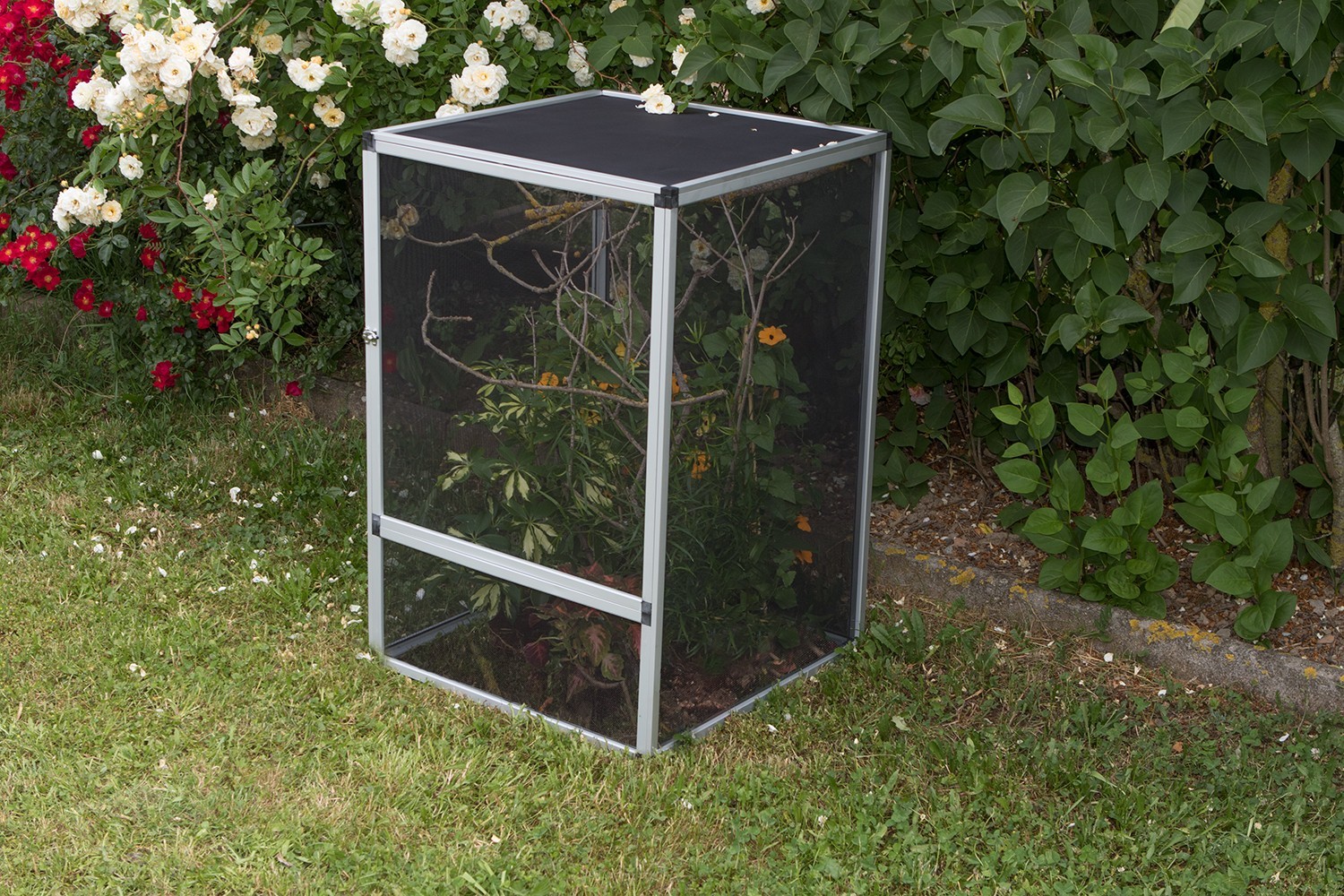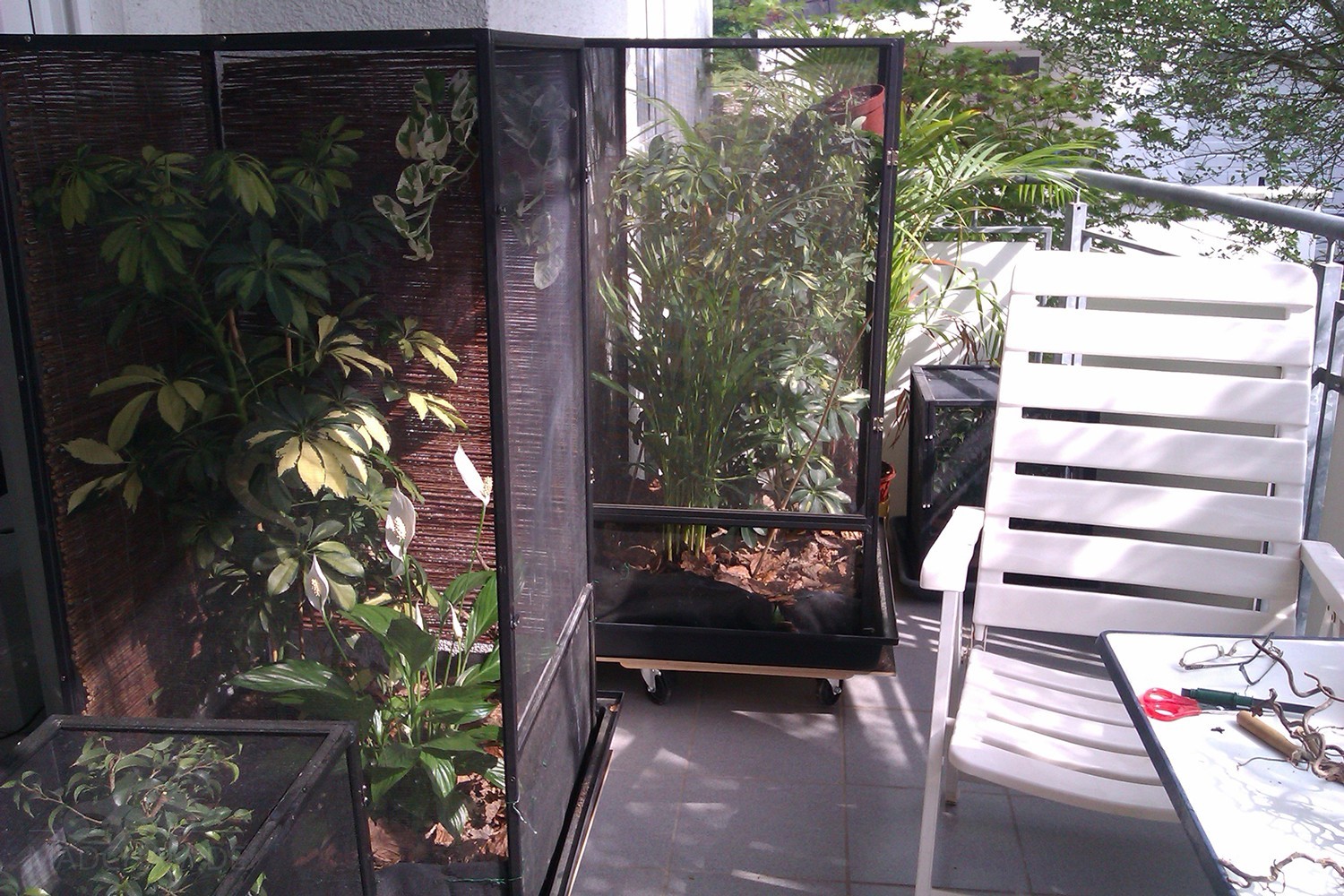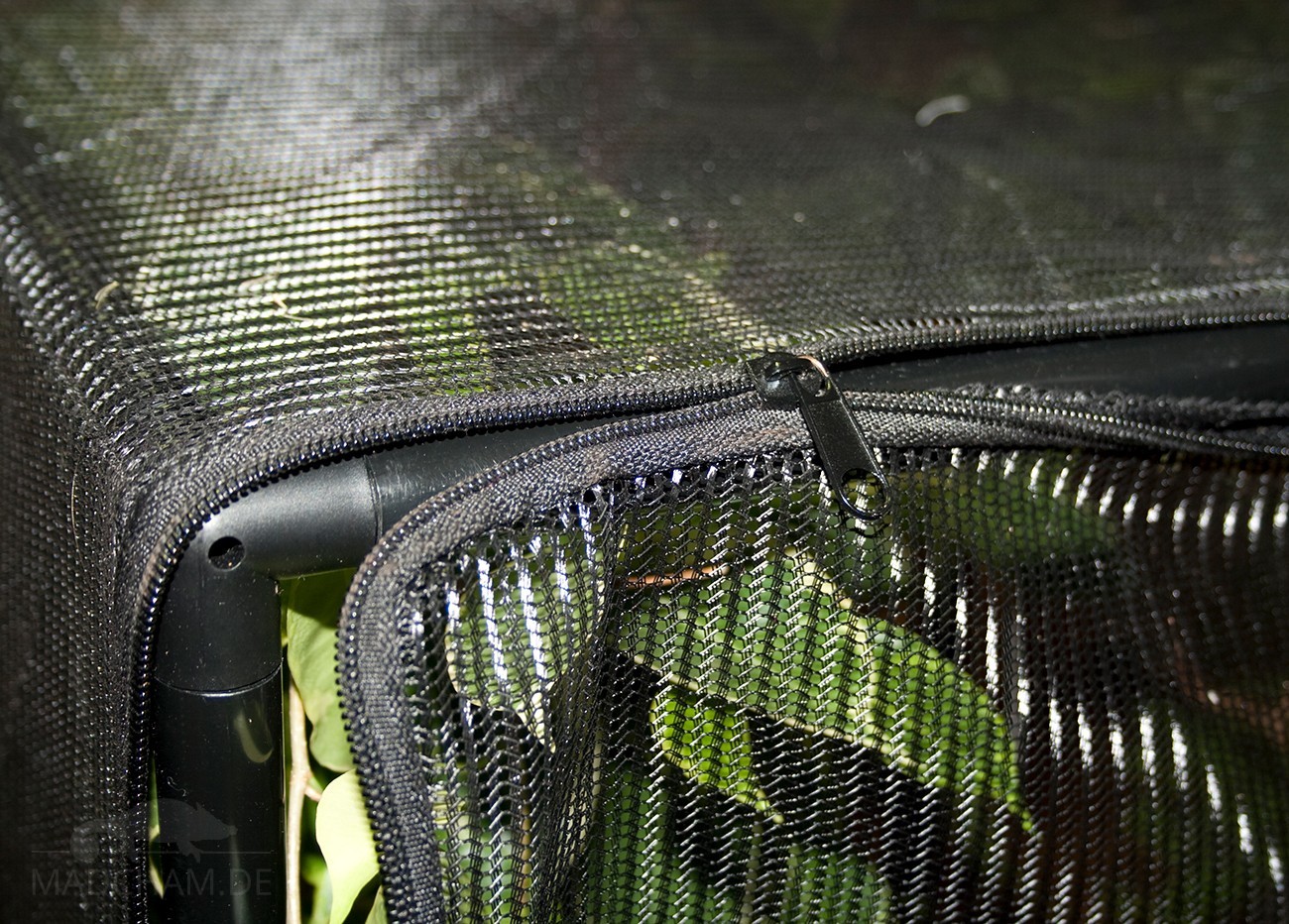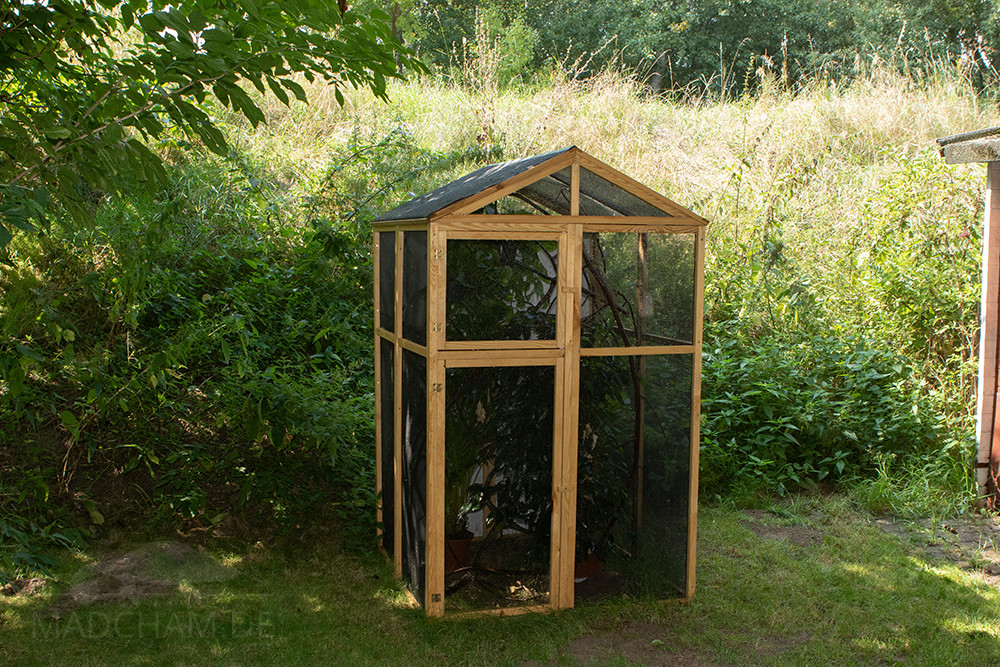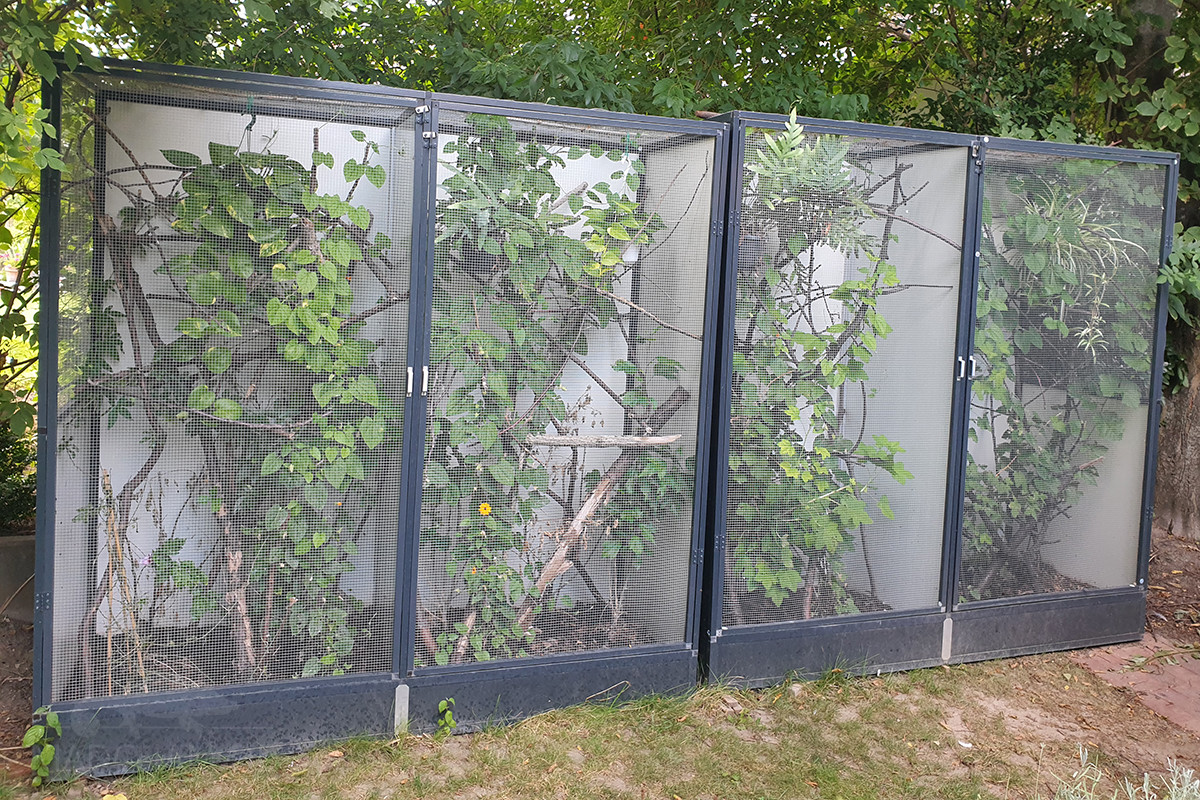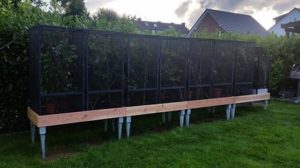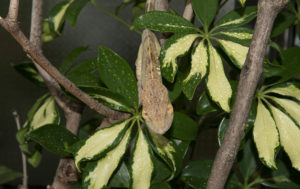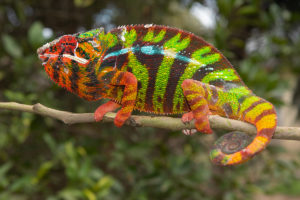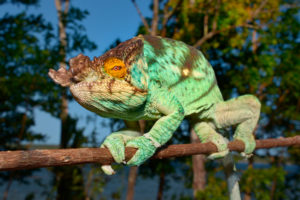Many chameleon species can be kept outside in Europe at least temporarily. Chameleons, like many other reptiles, benefit greatly from the real solar radiation, various weather influences and the natural temperature development in outdoor enclosures. They become more active on the balcony, terrace and in the garden, show their colouring much better and mate easier. There are a few things to consider when it comes to outdoor enclosures, which is why we have written this article. Above in the picture: On the left a usable outdoor enclosure, the right enclosure has to be greened before use.
The enclosure itself
Terrariums made entirely of aluminium gauze or cage grids are best suited as outdoor enclosures for keeping chameleons. Closed terrariums with glass panes can heat up very quickly in the sun and prevent the vital UVB radiation. Therefore, indoor terrariums are unsuitable for most outdoor purposes. The enclosure itself should be equipped with plenty of branches and living plants. Concerning the size one can orient oneself at the terrarium measurements inside. The larger, the more practical. Whoever has large chameleons or wants to have walk-in enclosures will not get around DIY enclosures. For smaller chameleon species or young animals there are various ready-made outdoor enclosures, commercially available online or in pet stores. We would like to present some variants and our experience with them in the following.
RepTerraX Screen Cage
Our absolute recommendation for holders of small and medium-sized chameleon species: The Screen Cages from RepTerraX. They are made of aluminium profiles covered with aluminium gauze. The profiles are well built and use a simple construction: You simply insert them into each other. This way you can disassemble the enclosure later if you don’t need it in winter. Through the black gauze you can see into the enclosure very well. 2/3 of the front surface serves as door. The screen cages have proven to be very stable, rust-free and easy to clean.
ReptiBreeze
ReptiBreeze are made by Zoo Med and consist of plastic profiles with metal gauze. The construction takes place with many small screws (in the building market there is a replacement in case of need), a dismantling and reconstruction is possible several times. Through the black gauze the view into the enclosure is good, about 2/3 of the front serve as door. In our experience ReptiBreeze are relatively stable, but not designed for years of outdoor use. Earlier models soon began to rust, but this problem should have been solved by now. A good alternative for chameleon enclosures on balconies or terraces that aren’t used permanently.
Flexariums
Flexariums from ExoTerra are nylon nets that are pulled over a plastic tube frame. They are easy to assemble and easy to transport. Due to the light weight and the zippers used to open it, however, we have come to know Flexariums as a rather wobbly and instable. The view through the nylon fabric is slightly darker than with metal gauze. We therefore regard flexariums as an inexpensive solution for temporary accommodation of chameleons or only for an hourly stay in the open air.
Aviaries
Bird aviaries are another alternative, especially for large chameleons. Indoor aviaries or bird cages are generally very susceptible to rust and are therefore not suitable for use. Ready-to-use, stainless external aviaries or lattice elements for construction are available in all sizes and shapes. Most of them are made of metal, very stable and designed for permanent outdoor use. Of course, they are correspondingly cost-intensive. It is important not to choose aviaries with wire or too large grid spacings (see Safety) and to make sure that the door openings are generous so that the chameleon can be easily caught out again.
DIY enclosures
A little more effort is a self-built enclosure, but you can design it exactly according to your own wishes and ideas. The proven aluminium profiles for terrariums offer stainless construction possibilities. You can also screw wooden frames together and paint them rainproof. Again, it is important not to use wire mesh or rabbit mesh, but gauze or other non-sharp material. Designing the majority of a side of the enclosure as a door makes it easier to reach into the enclosure and use it later. The picture shows an outdoor enclosure, for which we have a construction plan here.
Whether an enclosure needs to be covered depends mainly on the size and planting of the enclosure. Basically it is good for chameleons to sit in a rain shower in warm temperatures. Usually it even encourages them to drink. But also in nature, chameleons seek protection from the rain under dense canopies. So, for example, if you have low-stemmed fruit trees or dense bushes in a large outdoor enclosure that provide good protection, you do not need a roof over the enclosure. If the enclosure is less densely overgrown or rather small, a partial roofing can be helpful.
Location
The location of the enclosure should be well thought out. It is easiest to find a place in the garden: it is best to look for a place near a tree or big bush, which casts shade on 2/3 of the enclosure, and leaves almost 1/3 sunny places to warm up. On a balcony or terrace with free-standing enclosures you have to do some tricks and, if necessary, place a few bushes, palm trees or a small tree next to it in order to obtain sufficient shady areas. Sometimes a sun sail can also help. On balconies at lofty heights, one should also always think of a location protected from the wind.
And be careful – the sun wanders through the day! Sounds self-evident, but is often not considered. An enclosure that is in an unfavourable position can stand in the shade in the morning, but completely unprotected in the sun at noon. During the first test runs you should therefore supervise the chameleon and the enclosure in order to be able to make corrections or choose another location if in doubt.
Temperatures
In general, suitable temperatures should be taken into account – re-measuring is better than estimating. Chameleons, like all reptiles, can overheat when exposed to high temperatures and suffer frost damage at low temperatures. Overheated chameleons become very bright in colour, open their mouths and sometimes even walk around on the floor to find cooler places.
A thermometer in the sun area of the enclosure and one in the shade help to find the right location and the right time of year for outdoor time. It is best to measure during the day and at night to find out maximum, average and minimum temperatures. These can then be compared with the temperatures in the natural habitat. As a general rule, species found in the Madagascan highlands should not necessarily be exposed to the sun above 30°C in midsummer. A panther chameleon, on the other hand, which comes from the northwest coast, lives well in the shade with temperatures around 30°C, but does not want to come below 10°C at night. Chameleons also do well outdoors for hours – provided that the animals are used to handling. If the temperatures are right, chameleons can stay out in the enclosure overnight.
Chameleon enclosures should also be regularly sprayed with water outside, by hand or with the help of a rain system. If you want to lower the temperatures in the enclosure, wet towels and hourly spraying can also help. A dripper allows the chameleon to drink at will.
Safety in outdoor enclosures
If the enclosure is to stand in the garden, it is advisable to secure the ground with grids (buried or fixed to the ground). Otherwise martens or rats can dig into the enclosure from below and in the worst case seriously injure the chameleon. Rats are everywhere and not only in supposedly dirty or dilapidated residential areas. Even if you hardly see them during the day, they can still be around at night in the neighbourhood and in your own garden.
If you choose wide meshed grids for enclosure construction, insects as potential prey are more likely to enter the enclosure of the chameleon. Likewise, however, free-range cats, crows and other predators can injure chameleons more easily in wide- and soft-meshed enclosures. In this case, it may be considered to place a second wire mesh in some distance around the enclosure to prevent any interference. The potential risk of injury to the chameleon must also be taken into account if the wire is wide-meshed (depending on the tongue size of the chameleon) and coarse. It has happened that chameleons have shot through of rabbit wire to reach an insect, but seriously injured their tongues in retreat.
Heavy, large chameleon species also occasionally injure their feet on wires – therefore please pay attention to not sharp-edged wires and if necessary thicker variants for larger chameleon feet. You have to adjust the mesh size to the animal and especially its tongue size – for panther chameleons and larger species mesh sizes below 2 cm should be unproblematic. If enclosures are left unattended in the garden and children play nearby, it makes sense to install a small lock. Most enclosures are quickly opened, and the chameleon warmed up in the sun quickly disappears. Finally, of course, but we’ll mention it again anyway: If thunderstorms were announced, it’s safer to bring chameleons into their terrariums inside. Most enclosures do not offer too much area for wind to attack due to the gauze, but can be damaged by hail or may “take off” in a gust of storm.

